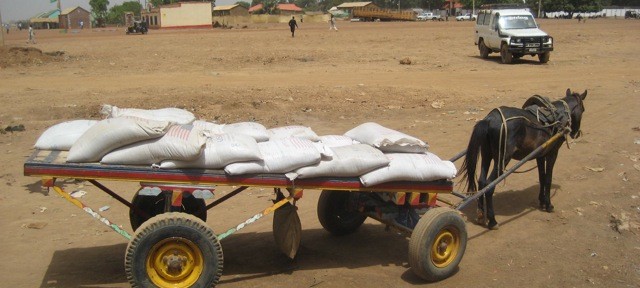Drop in the Bucket started off the New Year on a great note. We received a wonderful Christmas present this year from UNICEF in South Sudan. They donated two Land Cruisers to assist our field teams in our work. This is a tremendous upgrade for us from old beat down vehicles we’ve been getting around in.

Over the holidays, our always-reliable logistical director, George and one of our South Sudan consultants, Majodit, were in Juba dealing with everything related to the new trucks. They finalized our NGO registrations with the new government, got the trucks registered, insured and ready for action. I felt bad that they were spending time doing this when they should have been celebrating with their families, but they were insisting. We are all so grateful to now have safe, reliable transportation to navigate the treacherous, unpaved terrain.

George and Majodit’s dedication to our projects is incredible. These guys have fought their entire lives for the freedom of their country and they are extremely devoted to continuing to help with the struggle. They love being in a position to really help their people, many of whom are desperate for the most basic of services. Water, food and education are at the top of that list.
When I returned to the US for the holidays, the humanitarian community was preparing for the major influx of returnees that were coming back from the North into South Sudan. Driving through the streets of Aweil this time, it was clear that they had come…. and were still coming.
The UN estimates that since July around 328,000 people have returned to South Sudan. The final destination for 100,000 of them was Northern Bahr el Ghazal State (Aweil) and its two neighboring states.

The streets of Aweil were flooded with people. There were donkeys pulling carts loaded with USAID bags of sorghum, a local grain staple. The street kids were out in droves searching for a piece of bread or small change.
It is clear that the additional people are definitely taking a toll on the region and there is a food shortage that’s reached crisis level. Even the donkeys and horses around Aweil Town looked weak and hungry, with their bones protruding, as they struggled to haul their carts.
People are really guarded so I don’t take many photos. I don’t want to offend them or have them in any way think we are going to exploit the suffering.
We are careful to let people know that we want to hear from them, work WITH them to address their crisis.
Although there was a real sense of desperation in town, I knew things were even much worse in the villages. There are many areas that we can only access during the dry season (December – May). I learned that in August 2011 , at the same time we were doing our preliminary assessments in Aweil, 350 people had died of starvation in a remote returnee camp in the next state over, Warrap.
It’s so hard for me to accept that people are dying of starvation and from drinking contaminated water, when I see people around the world who have so much… and waste so much. But here there is no waste around here.
Food prices have gone through the roof, increasing by almost 50% since last August. Over the summer you could buy a 50-kilo bag of sorghum for 130 South Sudanese pounds. Now it’s 180 SSP. People cannot afford to feed their families.
Looking around at the dry barren landscape, you see a lot of potential farmland. And underground water is easily accessed, with the right equipment. The largest aquifer in all of Africa sits underneath this particular region. It’s rare to drill and not reach water. This is water that could also be used as irrigation for the vast stretches of farmland. It’s hard to believe that this area is so rich with untapped resources and, at the same time, the people are dying of hunger and from drinking contaminated water. But on a positive note, I’m meeting good, smart people out here every single day who are all collaborating to make a difference.
Categories
Back to the field with travel upgrades

